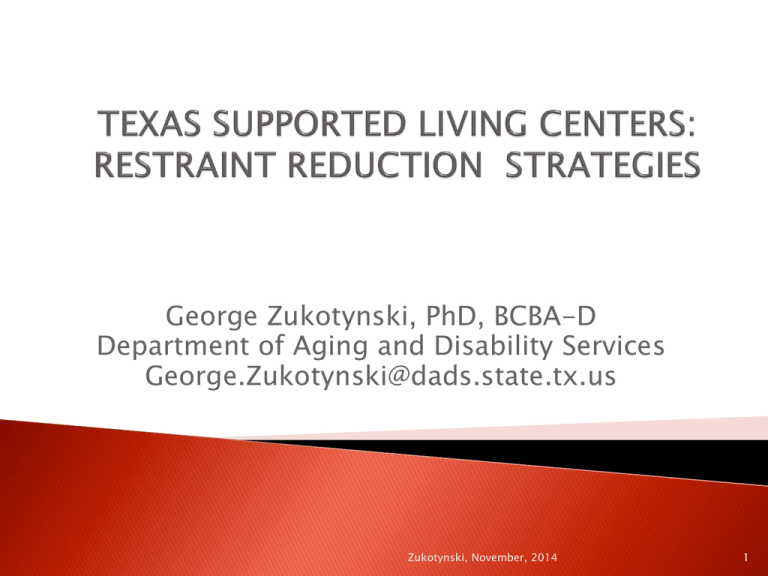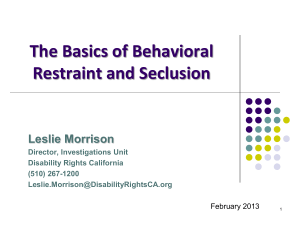Handout
advertisement

George Zukotynski, PhD, BCBA-D Department of Aging and Disability Services George.Zukotynski@dads.state.tx.us Zukotynski, November, 2014 1 Zukotynski, November, 2014 2 NADD for emphasizing support of ID and mental health State Office Staff of DADS SSLC Thirteen Directors of Behavior Health Services Direct Support Our individuals Note: None of the information provided necessarily represents the views of DADS, Texas, or DOJ Zukotynski, November, 2014 3 Describe an integrated approach to reduce restraints in a statewide system of supported living centers Delineate the differences between crisis intervention restraint, medical restraint, and protective mechanical restraint for self-injurious behavior and reduction strategies. Describe the six core strategies for reducing restraint and seclusion (National Association of State MH Program Directors). Zukotynski, November, 2014 4 13 Supported Living Centers Supporting 3391 individuals Ranges in age and functioning level Two Centers for alleged MR offenders DOJ Settlement Agreement ◦ Scheduled Monitoring ◦ Section C on Restraints ◦ Impacts on policies, documentation, implementation ◦ Impacts on total quality of programs Zukotynski, November, 2014 5 Crisis Intervention Restraints •Protection from imminent danger •Physical; prone/supine prohibited •Mechanical •Chemical •Special IDT when more than three in a rolling 30 days Zukotynski, November, 2014 6 Protective Mechanical Restraints for SIB Mechanical restraint applied to prevent the danger of imminent danger due to SIB Zukotynski, November, 2014 7 Medical or Dental Restraint Absolutely necessary for procedure Absolutely necessary for the prevention of undoing of treatment (medical healing) Zukotynski, November, 2014 8 For restraints that are not emergency a restraint plan is required ◦ Instructions to staff on the application of restraint ◦ For crisis intervention it includes behavioral descriptions of imminent danger ◦ Instructions on how to remove restraint For each restraint plan there is a plan for restraint reduction ◦ PBSP reinforcing functional replacement behavior ◦ A fading schedule for protective mechanical ◦ Healing condition has resolved Zukotynski, November, 2014 9 SIX CORE STRATEGIES DOJ SETTLEMENT LEADERSHIP GROUP AGREEMENT RESTRAINT REDUCTION STATE POLICES AND RULES SENATE BILL 41 TRAUMA INFORMED CARE Zukotynski, November, 2014 10 2005 2007 2012 • Six Core Strategies to Reduce the Use of Seclusion and Restraint • Texas Seclusion and Restraint Reduction Leadership Group • Hogg Foundation Sponsors Training and Consultation on Trauma Informed Care at two Centers for Alleged Offenders Zukotynski, November, 2014 11 DATA LEADERSHIP WORK FORCE COMSUMER DEBRIEFING PREVENTION Zukotynski, November, 2014 12 2009 2011 2012 • DOJ Settlement Agreement • Senate Bill 41 Prohibits Restraint in PBSPs • Revised Restraint Policy: definitions, checklists, restraint plans, release requirements Zukotynski, November, 2014 13 2013 2014 •Texas Administrative Code: New Restraint Rules •Revised Restraint Policy: behavior and biology; adjusted release time to shorter intervals; processing plans Zukotynski, November, 2014 14 Centers use standard documentation checklists to document crisis intervention, medical, or protective mechanical restraint Draft copies are reviewed and finalized at the Center Data is typed into the system The data is placed in the Dashboard Zukotynski, November, 2014 15 This case study presented longitudinal aggregate data across 13 Centers with a chronology of ecobehavioral changes (Ferlinger, 2008) from 2012-2014. ◦ Cultural factors: Six Core Strategies, Leadership Group, Trauma Informed Care Training ◦ Governmental requirements: 2012 policy, Texas rules, 2014 policy ◦ DOJ Settlement Agreement ◦ A variety of trends are seen with some indicating decrease in restraint To date, there is only limited published research on restraint reduction Williams (2010), in a review of restraint reduction studies categorizes five distinct approaches, several of which are in use in Texas ◦ ◦ ◦ ◦ ◦ Restraint fading for SIB Staff Training Assessment/modification of antecedent conditions Modification of response contingent release criteria to a fixed-time release Successful behavioral treatment Zukotynski, November, 2014 23 Williams and Grossett (2011) set up organizational requirements for mechanical restraint use: a behavior plan must be developed to reduce restraint and a plan to reduce injuries to self or others. ◦ Texas Administrative Code now requires a restraint plan and a PBSP to reduce restraint and increase replacement behavior Luiselli (2009) in a review of restraint reduction lists the following organizational strategies and clinical approaches ◦ ◦ ◦ ◦ ◦ ◦ Making criteria more stringent Requiring more accurate and complete documentation Performance improvement project Staff training Antecedent assessment and intervention Fixed-time release Zukotynski, November, 2014 24 Restraints versus supports Mechanical restraint versus protective device Medical procedures with medication vs restraint Fixed time release for crisis intervention Least restrictive approach to crisis Psychiatric emergency medication versus chemical restraint Research on restraint reduction Research on de-escalation skills Zukotynski, November, 2014 25 Ferlinger, D. (2008). Human services restraints: Its past and future. Intellectual and Developmental Disabilities, 46, 154-165. Huckshorn, K (2005). Six core strategies to reduce the use of seclusion/restraint. National Association of State MH Program Directors. www.nasmhpd.org Luiselli, J.K. (2009). Physical restraint of people with intellectual disability: A review of implementation reduction and elimination procedures. Journal of Applied Research in Intellectual Disabilities, 22, 126-134. Williams, D.E., (2010). Reduction and eliminating restraint of people with developmental disabilities and severe behavior disorders: An overview of recent research. Research in Developmental Disabilities 31,1142-1148. Williams, D.E. & Grossett, D.L. (2011) Reduction of restraint of people with intellectual disabilities: An organization behavior management t (OBM) approach. Research in Developmental Disabilities, 32, 2336-2339. Zukotynski, November, 2014 26








